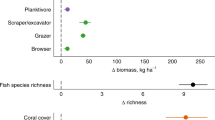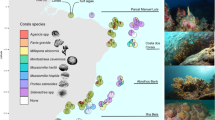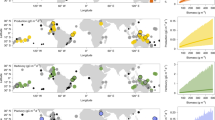Abstract
Mangrove forests are one of the world's most threatened tropical ecosystems with global loss exceeding 35% (ref. 1). Juvenile coral reef fish often inhabit mangroves2,3,4,5, but the importance of these nurseries to reef fish population dynamics has not been quantified. Indeed, mangroves might be expected to have negligible influence on reef fish communities: juvenile fish can inhabit alternative habitats and fish populations may be regulated by other limiting factors such as larval supply or fishing6. Here we show that mangroves are unexpectedly important, serving as an intermediate nursery habitat that may increase the survivorship of young fish. Mangroves in the Caribbean strongly influence the community structure of fish on neighbouring coral reefs. In addition, the biomass of several commercially important species is more than doubled when adult habitat is connected to mangroves. The largest herbivorous fish in the Atlantic, Scarus guacamaia, has a functional dependency on mangroves and has suffered local extinction after mangrove removal. Current rates of mangrove deforestation are likely to have severe deleterious consequences for the ecosystem function, fisheries productivity and resilience of reefs. Conservation efforts should protect connected corridors of mangroves, seagrass beds and coral reefs.
This is a preview of subscription content, access via your institution
Access options
Subscribe to this journal
Receive 51 print issues and online access
$199.00 per year
only $3.90 per issue
Buy this article
- Purchase on Springer Link
- Instant access to full article PDF
Prices may be subject to local taxes which are calculated during checkout


Similar content being viewed by others
References
Valiela, I., Bowen, J. L. & York, J. K. Mangrove forests: One of the world's threatened major tropical environments. Bioscience 51, 807–815 (2001)
Rooker, J. R. & Dennis, G. D. Diel, lunar and seasonal changes in a mangrove fish assemblage off southwestern Puerto Rico. Bull. Mar. Sci. 49, 684–698 (1991)
Claro, R. & Garcia-Arteaga, J. P. Estructura de las communidades de peces asociados a los manglares del groupo insular sabana-camaguey. Cuba. Avicennia 10, 60–83 (1993)
Ley, J. A., McIvor, C. C. & Montague, C. L. Fishes in mangrove prop-root habitats of northeastern Florida bay: distinct assemblages across an estuarine gradient. Estuar. Coast. Shelf Sci. 48, 701–723 (1999)
Nagelkerken, I. et al. Dependence of Caribbean reef fishes on mangroves and seagrass beds as nursery habitats: a comparison of fish faunas between bays with and without mangroves/seagrass beds. Mar. Ecol. 214, 225–235 (2001)
Caley, M. J. et al. Recruitment and the local dynamics of open marine populations. Annu. Rev. Ecol. System. 27, 477–500 (1996)
Chapman, M. R. & Kramer, D. L. Movements of fishes within and among fringing coral reefs in Barbados. Environ. Biol. Fish. 57, 11–24 (2000)
Purdy, E. G. & Gischler, E. The Belize margin revisited: 1. Holocene marine facies. Int. J. Earth Sci. 92, 532–551 (2003)
Sullivan-Sealey, K. & Bustamente, G. Setting Geographic Priorities for Marine Conservation in Latin America and the Caribbean (Arlington, VA, The Nature Conservancy, 1999)
Clarke, K. R. Non-parametric multivariate analyses of changes in community structure. Aust. J. Ecol. 18, 117–143 (1993)
Nagelkerken, I. et al. How important are mangroves and seagrass beds for coral-reef fish? The nursery hypothesis tested on an island scale. Mar. Ecol. 244, 299–305 (2002)
Ogden, J. C. in Life and Death of Coral Reefs (ed. Birkeland, C.) 288–297 (Chapman and Hall, New York, 1997)
Laegdsgaard, P. & Johnson, C. Why do juvenile fish utilise mangrove habitats? J. Exp. Mar. Biol. Ecol. 257, 229–253 (2001)
Manly, B. F. J. The Design and Analysis of Research Studies (Cambridge Univ. Press, Cambridge, 1992)
Randall, J. E. Food habitats of reef fishes of the West Indies. Stud. Trop. Oceanogr. 5, 665–847 (1967)
International Union for Conservation of Nature and Natural Resources (IUCN) 2002 IUCN Red List of Threatened Species 〈http://www.redlist.org〉 (2002)
Serafy, J. E., Faunce, C. H. & Lorenz, J. J. Mangrove shoreline fishes of Biscayne bay (Bull. Mar. Sci., Florida
Pandolfi, J. M. et al. Global trajectories of the long-term decline of coral reef ecosystems. Science 301, 955–958 (2003)
Gunderson, L. H. Ecological resilience—in theory and application. Annu. Rev. Ecol. System. 31, 425–439 (2000)
McNeill, S. E. The selection and design of marine protected areas: Australia as a case study. Biodiv. Conserv. 3, 586–605 (1994)
Knowlton, N. The future of coral reefs. Proc. Natl Acad. Sci. USA 98, 5419–5425 (2001)
Green, L. E. & Alevizon, W. S. Comparative accuracies of visual assessment methods for coral reef fishes. Bull. Mar. Sci. 44, 899–912 (1989)
Nagelkerken, I., Dorenbosch, M., Verberk, W., de la Moriniere, E. C. & van der Velde, G. Importance of shallow-water biotopes of a Caribbean bay for juvenile coral reef fishes: Patterns in biotope association, community structure and spatial distribution. Mar. Ecol. 202, 175–192 (2000)
Bohnsack, J. A. & Harper, D. E. Length-Weight Relationships of Selected Marine Reef Fishes from the Southeastern United States and the Caribbean Technical Memorandum NMFS-SEFC-215 (National Oceanic and Atmospheric Administration, Miami, Florida, 1988)
Acknowledgements
We thank T. Green for help with the online figures; B. Cowen, J. Pandolfi, S. Palumbi, D. Snyder, F. Micheli, B. Brown and J. Bythell for comments on the manuscript. We thank the National Geographic Society, the US World Wildlife Fund (WWF-US) and The Royal Society for funding. Field work was supported in part by the Lighthouse Reef Resort.
Author information
Authors and Affiliations
Corresponding author
Ethics declarations
Competing interests
The authors declare that they have no competing financial interests.
Supplementary information
41586_2004_BFnature02286_MOESM5_ESM.doc
Supplementary information on the biomass of scarids: Proportion of total scarid biomass represented by a single individual of S. guacamaia. (DOC 23 kb)
Rights and permissions
About this article
Cite this article
Mumby, P., Edwards, A., Ernesto Arias-González, J. et al. Mangroves enhance the biomass of coral reef fish communities in the Caribbean. Nature 427, 533–536 (2004). https://doi.org/10.1038/nature02286
Received:
Accepted:
Issue Date:
DOI: https://doi.org/10.1038/nature02286
This article is cited by
-
Changes in Benthic Habitat Under Climate Pressure in Western Papua, Indonesia: Remote Sensing-Based Approach
Journal of the Indian Society of Remote Sensing (2024)
-
Importance of coastal vegetated habitats for tropical marine fishes in the Red Sea
Marine Biology (2023)
-
Invasive lionfish dispersal between shallow- and deep-water habitats within coastal Floridian waters
Biological Invasions (2023)
-
Decreases in mangrove productivity and marsh die-off due to temporary increase in salinity, a case in Mexico
Hydrobiologia (2023)
-
Drivers of global mangrove loss and gain in social-ecological systems
Nature Communications (2022)
Comments
By submitting a comment you agree to abide by our Terms and Community Guidelines. If you find something abusive or that does not comply with our terms or guidelines please flag it as inappropriate.



